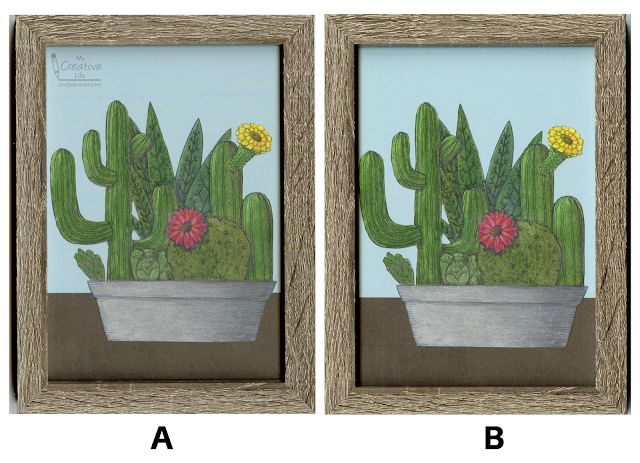Which do you prefer, A or B? What do you prefer about it?
Both A and B are scans of exactly the same thing, a framed image of a pot of cacti. Yet, the same item scanned with some subtle differences. And it's one of those differences that makes me prefer one over the other.
To back up a bit, I have a few more frames that match the one I used to frame the Love Grows images for my mom. So I chose another image from the same book to color and frame for her. It was a fun challenge to make the cacti all look distinct and to consider where the shadows would fall amongst so many overlapping things. I'm learning more every time I practice, so I'm not beating myself up over the mistakes. My mom will neither notice nor care.
I popped the completed frame on the scanner and got this:
My eye went immediately to the cactus on the left. It looks like it's directly up against the frame, but it is not. The shadow makes it look that way. This confused me. Since the frame was directly on the surface of the scanner, the light shouldn't be directional, right? Wrong. When I turned the frame 180° and scanned again, I got this:
The shadows are on the opposite sides, which allows the bit of blue that's actually there on the left to show. (It also shows a faint line across the blue, just above the cactus. It's actually there on the other one, but because it's in the brown and lined up with the pot, it's much harder so see. I hope it means the scanner needs cleaning and not that it is damaged or starting to fail.)
Here are the scans side-by-side again:
While I prefer the alignment of A because the left side has a tiny bit of breathing room, the colors of B look brighter and more natural to me. The colors are not actually different. It seems that way because of the shadows.
In A, the shadows of the frame fall to the left. In B, they fall to the right. Since I colored the cacti with the light source on the left and the shadows to the right, the frame's shadows in B match those of the colored image. Of course, in real life, the location of the frame's shadows depends on where it is hung and what the light sources are.
Despite all the time I've spent in art museums, I've never appreciated the effort that must go into lighting the pieces correctly. I'm going to be paying close attention to that next time.




I think the scanner was designed for flat surfaces. I'm sure you will get a more accurate photo using a camera.
ReplyDelete